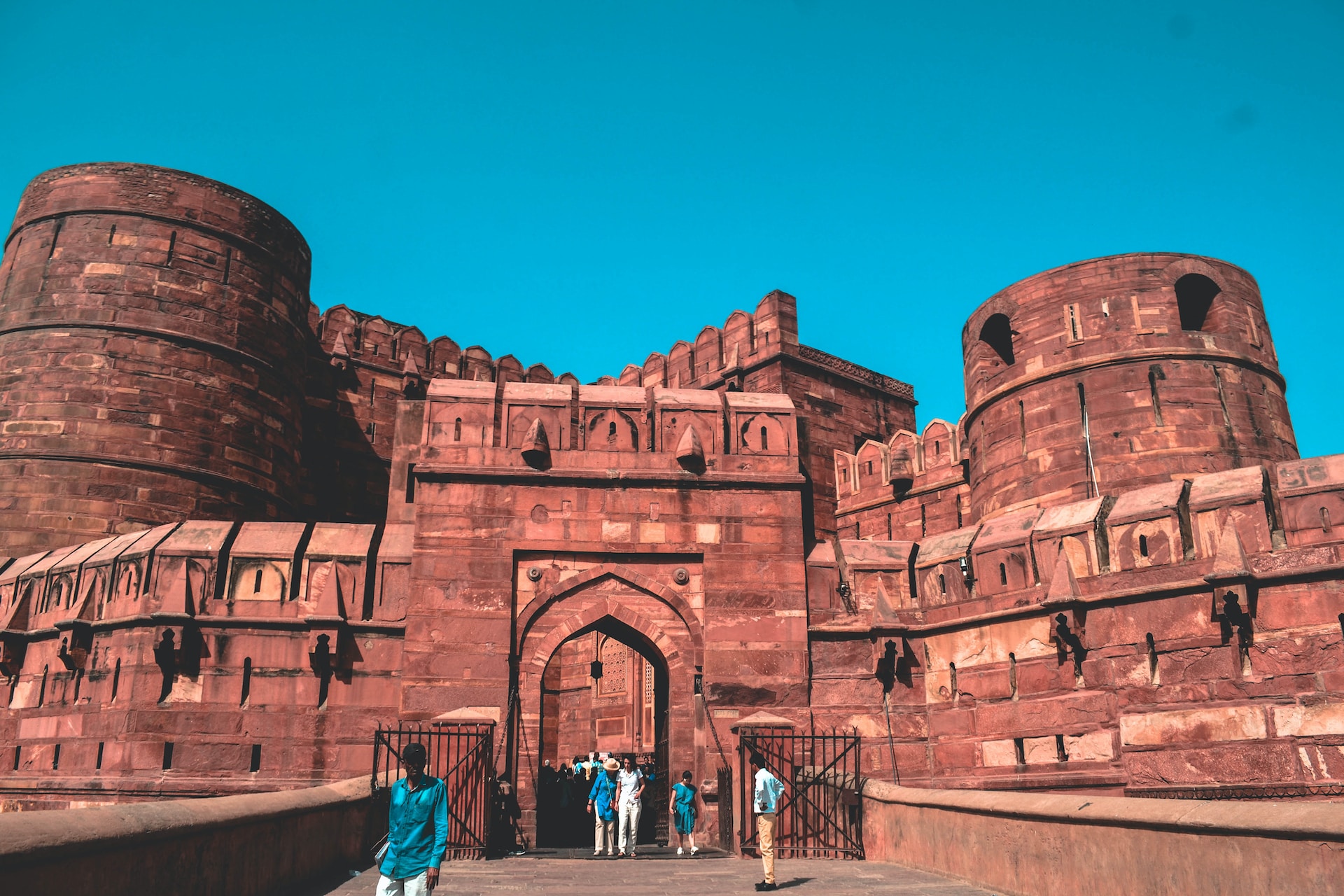One of the greatest Mughal Emperors, Akbar, oversaw the construction of the Agra Fort in the year 1573. The fort was finished after eight grueling years and the labor of more than 4,000 people. Akbar constructed the fort to serve as the Mughals’ primary residence because he understood the value of its position. Up to the year 1638, the fort served as the Mughal dynasty emperors’ primary home. The Jahangir Mahal, Khas Mahal, Diwan-i-Khass, Diwan-i-Am, Machchhi Bhawan, and Moti Masjid are just a few of the fort’s magnificent architectural wonders.
The Agra Fort lost its prominence as the Mughal kings’ primary home when the Mughal dynasty’s capital was transferred from Agra to Delhi in 1638. Just 2.5 km separate the fort from the Taj Mahal, its sister landmark. Agra Fort is a UNESCO World Heritage monument and is frequently referred to as a walled city. The fort is a popular tourist destination today, drawing visitors from all over the world.
History of the Fort
Agra Fort is renowned for its lengthy history. The fort has previously been possessed by numerous emperors and monarchs, enduring numerous renovations to its exterior. Everything began with the first battle of Panipat, fought in 1526 between Babur and Ibrahim Lodi of the Lodi dynasty. Babur adopted Ibrahim Lodi’s palace and fort as his residence after defeating him. The fort was later altered by him by adding a sizable step well (baoli) inside. The fort quickly rose to prominence as a significant Mughal monument. In reality, the fort hosted the coronation of Humayun, Babur’s successor, in the year 1530.
As soon as other dynasties’ emperors began to show interest in the fort, conquest efforts against it began. Sher Shah Suri of the Sur Empire engaged Humayun in battle in 1540 and ultimately defeated him at Bilgram. When Sher Shah Suri bought the fort from Humayun, he made a few modest modifications to fit his own style in architecture. The Sur dynasty’s emperors controlled the fort for the following 15 years. Humayun was successful in retaking Agra and the fort in 1555. However, Hemu Vikramaditya, Adil Shah Suri’s (the last emperor of the Sur dynasty) general and military leader, seized Agra a year later. He chased the retreating army to Delhi, where he and Tardi Beg Khan, the Mughal military commander, engaged in the Battle of Tughlaqabad.
Tardi Beg Khan was soundly defeated in the conflict, and Hemu Vikramaditya anointed himself king. But on November 5, 1556, just one month into Hemu’s reign as king, Akbar, and his army invaded Delhi and routed Hemu’s armies. The Mughals once more owned the fort, although it was quickly falling apart. Back then, it was made entirely of bricks and was known as Badalgarh. Akbar made the decision to construct it out of red sandstone after realizing its historical and contextual importance.
The fort underwent significant transformations and assumed its present shape during the rule of Shah Jahan. Some of the fort’s buildings were demolished by Shah Jahan, who then reconstructed it to suit his own tastes in architecture. The Maratha Empire seized control of the fort around the beginning of the 17th century. The fort had a number of owners during this time, including many Maratha emperors and their adversaries, many of whom were Mughal emperors. The founder of the Durrani Empire, Ahmad Shah Durrani, decisively defeated the Marathas in 1761. The fort served as the residence of the Durrani dynasty monarchs until 1785. Under Mahadji Shinde’s rule, the Marathas took back control of the fort in 1785. The fort was later lost by the Marathas in their conflict with the British during the Second Anglo-Maratha War. Until it was turned over to the government of India in 1947, the British were able to relax in the fort.
You can learn more about other historical monuments from the article about Top 7 Famous Monuments in India
Layout of the Fort
From above, the fort appears to be semicircular. The Yamuna River bank is seen from the fort’s base. A huge red sandstone wall with multiple battlements surrounds the Agra Fort. This wall’s roughly 2-kilometer perimeter is broken up by sweeping bends and towering bastions. The fort’s walls are towering 70 feet tall. The fort is about 2.5 kilometers long. There are four gates on it, one on each side. The Delhi gate and Lahore gate are the two most noticeable of the four gates. Later, the Lahore Gate was changed to the Amar Singh Gate. The Delhi gate functioned as both Akbar’s principal entry and a line of defense against the invaders. The Elephant Gate is the name for one of the interior entrances. Even with the aid of war elephants, the invaders found it challenging to penetrate the fort due to the way the openings were constructed. The Delhi gate is still used by the Indian army for security reasons.
There are many palaces and halls in the fort. The three most notable palaces are Shah Jahani Mahal, Khas Mahal, and Macchi Bhavan. The courtyard is accessible via the Amar Singh gate. On the right is the majestic Diwan-I-Am (Hall of Public Audience). The royal pavilions, which house the well-known Nagina Masjid and Mina Masjid, were located a short distance away. The princesses used the fort’s marble royal baths, which are also present. Additionally, within the fort, halls of worship and a women-only marketplace were constructed. A hidden entrance was created at the fort’s base so that it could be easily reached in an emergency. The fort’s other highlights include courtrooms, a courtyard, a mirror palace (Shish Mahal), a grape garden, a jasmine tower, a mirror palace, and the ruins of Akbar’s once-impressive palace. It is reported that the fort once contained 500 gorgeous-looking structures. Unfortunately, a large number of the structures were demolished at different times for different causes.
Architecture
The foundation of the Agra Fort was made of bricks. The exterior surfaces were covered with red sandstone that was transported all the way from Rajasthan. Back then, red sandstone was used to construct the complete fort. During Shah Jahan’s rule, the fort’s exterior received a significant modification. Shah Jahan, unlike his grandfather, was enamored with the beauty of white marble. As a result, he completely destroyed many of the fort’s structures before rebuilding them out of white marble. The Musamman Burj of the Agra fort, which Shah Jahan himself built, was where he was forced to spend his dying days. To the left of the Khaas Mahal is where you’ll find the Musamman Burj. It is a lovely open pavilion octagonal tower. According to legend, Shah Jahan used to look at the Taj Mahal from this very location.
More alterations were done to the Agra Fort once it came under British control. They demolished numerous historically significant buildings and structures under the pretext of building barracks and for political reasons. The buildings that have survived serve as examples of the true complexity and craftsmanship of Mughal design. The Delhi Gate, Amar Singh Gate, and Bengali Mahal are outstanding examples of Mughal architecture within the fort. These buildings exhibit not just Mughal architecture but also excellent instances of Akbari architecture, commonly referred to as Indo-Islamic architecture. For its craftsmanship and architectural style, the Delhi Gate is regarded as the most notable of these buildings. It is still regarded as one of Akbar’s masterpieces today. In relation to masterpieces, there is a fascinating narrative about the design of the Agra Fort. It is reported that the fort’s royal apartments were constructed so that they would stay cool even on the hottest summer days. According to folklore, in order to keep the walls cool, they were built hollow and then filled with river water.
Useful Article: The Best Places to Visit in India for First-Time Travelers
Important Structures Inside the Agra Fort
- Jahangir’s Hauz: Jahangir constructed this massive tank. In the beginning, bathing took place in the tank. The Bengali Mahal of Akbar presently contains it.
- Shahjahani Mahal: The Shahjahani Mahal was most likely one of Emperor Shah Jahan’s first attempts to convert a red sandstone palace into a palace made of white marble.
- Babur’s Baoli (step well): Babur constructed a stone step well to supply water to the old fort of Agra. One of the fort’s first alterations was possibly this one.
- Nagina Masjid: The Nagina Masjid mosque was built by Shah Jahan. Only white marble was used in the construction of the mosque, which was regarded as a haven of seclusion.
- Diwan-I-Am (Hall of Public Audience): Shah Jahan constructed this hall. Strangely, the hall was first constructed from red sandstone but was later shell-plastered to give it the appearance of white marble.
- Ghaznin Gate: The mausoleum of Mahmud of Ghazni, one of the kings of the Ghaznavid Empire, is where the Ghaznin Gate genuinely resides. For political considerations, the British relocated the gate into the fort.
- Bengali Mahal: This was constructed by Akbar and then altered by Shah Jahan. This palace has an intriguing feature in that there are rumored to be hidden buildings there.
- Akbar’s Mahal: The fort still contains the remnants of Akbar’s renowned palace. Within the walls of this palace, Akbar passed away. Red sandstone was used to construct the entire palace.
The Secret Within
There are numerous hidden underground residences and structures in The Secret Within Agra Fort. It is reported that tunnels and other subterranean passageways connect the entire fort. The secret tunnels are claimed to have been built by the emperors who controlled the fort during their different reigns, according to historians, for obvious reasons. One such tunnel that connects the fort to the Yamuna riverbanks is situated close to the Water Gate.



